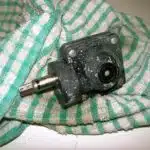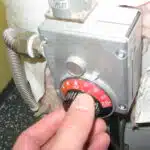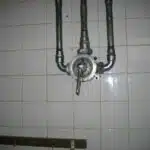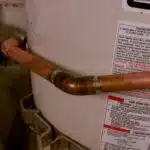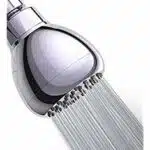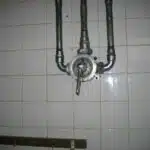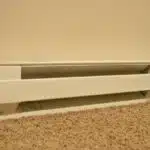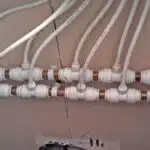As a plumbing expert, I understand the importance of consistent water temperature in any household. Inconsistent water temperature can lead to frustration, discomfort, and even safety hazards. It is imperative to address this issue promptly and efficiently for the sake of the homeowners’ convenience and overall well-being.
Inconsistent water temperature can occur due to various reasons such as malfunctioning plumbing fixtures or incorrect installation. It is crucial to identify the root cause of the problem before attempting any fixes. In this article, I will guide you through the steps to diagnose and fix inconsistent water temperature issues in your home’s plumbing system. By following these steps, you can ensure a safe and comfortable environment for yourself and your loved ones.
Identifying The Symptoms Of Inconsistent Water Temperature
When it comes to inconsistent water temperature, it can be compared to a rollercoaster ride. A rollercoaster has its ups and downs that can cause anxiety and discomfort for its riders. Similarly, inconsistent water temperature can be frustrating and uncomfortable for homeowners. It’s important to identify the symptoms of this problem before seeking any solutions.
Common causes of inconsistent water temperature include issues with the thermostat, sediment buildup in the tank, a malfunctioning heating element, or even problems with the plumbing system. These causes may affect one’s daily life as they can lead to unexpected cold showers or scalding hot baths. Inconsistent water temperature can also impact household chores such as doing laundry or washing dishes.
As a plumbing expert, it’s crucial to address these issues promptly to prevent further damage and inconvenience. Checking your water heater is one of the first steps towards resolving inconsistent water temperature issues. By doing so, you’ll be able to detect any underlying problems and take appropriate measures in fixing them.
Checking Your Water Heater
When experiencing inconsistent water temperature, one of the first things to check is your water heater. Common causes of this issue include a faulty thermostat, sediment buildup in the tank, or a malfunctioning heating element. In order to diagnose and fix these issues, it is important to know how to properly check your water heater.
Firstly, turn off the power supply to the water heater and allow it to cool down before beginning any inspection or repair work. Next, check the thermostat setting and adjust it accordingly if necessary. If the temperature still fluctuates after adjusting the thermostat, then sediment buildup may be the culprit. DIY solutions for this include draining some of the water from the tank or using a descaling solution.
Another possible cause of inconsistent water temperature is a malfunctioning heating element. This can be diagnosed by testing for continuity with a multimeter and replacing the element if necessary. It is important to note that if you are not comfortable working with electricity or performing these tasks on your own, it is always best to contact a professional plumber for assistance.
Inspecting your plumbing fixtures can also help identify other potential causes of inconsistent water temperature. Keep reading for tips on how to properly inspect your fixtures and make any necessary repairs or replacements.
Inspecting Your Plumbing Fixtures
It’s always a joy to turn on the faucet and be greeted by a sudden rush of unexpectedly hot or cold water, especially when you’re in a hurry. Inconsistent water temperature can be an exciting addition to your morning routine, but it can also be annoying and frustrating. The good news is that there are ways to fix this problem without calling a professional.
Common causes of inconsistent water temperature include faulty thermostats in faucets, damaged or worn-out washers, and mineral buildup inside pipes. These issues can be quickly resolved with some DIY solutions like cleaning and replacing parts or flushing out your plumbing system. However, if the problem persists after trying these methods, it may be time to call in a professional for an inspection.
A professional inspection will involve a thorough examination of your plumbing fixtures to identify any underlying problems that may be causing inconsistent water temperatures. Once the source of the issue has been identified, a cost analysis will determine how much it will take to fix the problem. This option is best suited for individuals who lack the technical know-how required for DIY solutions or those who are too busy to tackle such projects themselves.
Checking your pipes for blockages is the next step in ensuring consistent water temperatures throughout your home. By removing any obstructions from your pipes, you’ll allow water to flow more freely through them, which reduces stress on your plumbing system and ensures that hot and cold water reach their intended destinations. This process is simple enough for anyone with basic plumbing skills to complete on their own.
Checking Your Pipes For Blockages
After inspecting your plumbing fixtures, it is essential to check your pipes for blockages. Blocked pipes can cause inconsistent water temperature and affect the overall performance of your plumbing system. One way to check for blockages is by running water through each fixture in your home and observing the flow rate and temperature. If you notice any changes in the water pressure or temperature, it could be an indication of a blocked pipe.
Another common cause of inconsistent water temperature is leaks in your plumbing system. Leaks can occur anywhere in your plumbing system, from pipes to faucets, and can result in low water pressure and irregular temperatures. To check for leaks, inspect all visible pipes and faucets for signs of water damage or moisture buildup. If you notice any leaks, it’s best to call a professional plumber immediately to fix the issue before it causes further damage.
If you have checked for blockages and leaks but are still experiencing inconsistent water temperature, it may be time to flush your water heater. Over time, sediment buildup can accumulate at the bottom of your tank-style water heater, reducing its efficiency and causing fluctuations in water temperature. Flushing your water heater involves draining all the sediment out of the tank using a hose attached to the drain valve. It’s important to follow specific instructions when flushing your water heater to ensure that you do not damage it or injure yourself in the process.
Flushing Your Water Heater
Water heater maintenance is essential to ensuring consistent water temperature in your home. Flushing your water heater is one of the best ways to maintain your unit and keep it running efficiently. Over time, sediment and mineral deposits can accumulate at the bottom of your tank, which can cause inconsistent water temperature and reduce the lifespan of your unit.
Flushing your water heater involves draining all the water out of your tank, which helps get rid of any accumulated sediment. Before flushing, make sure you turn off power or gas to the unit and shut off the cold-water supply. Then connect a hose to the drain valve at the bottom of your tank and run it outside or into a bucket. Open up the valve to let all the water drain out, making sure there aren’t any blockages or leaks in the hose.
Troubleshooting water temperature issues can be frustrating, but by following these maintenance tips, you can prevent many common problems from occurring. Flushing your system once a year is recommended for optimal performance. If you continue to experience inconsistent water temperature after flushing or have other problems with your unit, it’s best to call in a professional plumber who can diagnose and fix more complex issues that may be affecting your system’s performance.
Transition: Now that we’ve covered how to flush your water heater for better consistency in water temperature let’s take a look at adjusting your thermostat for optimal performance.
Adjusting Your Water Heater’s Thermostat
Imagine taking a shower on a chilly winter day, and the water suddenly turns scorching hot. Or worse yet, when you’re washing dishes and the temperature fluctuates between hot and cold. Inconsistent water temperature can be frustrating, especially when you least expect it. However, adjusting your water heater’s thermostat can help alleviate this problem.
Reasons for inconsistent water temperature could include a malfunctioning thermostat or heating element, sediment build-up in the tank, or insufficient insulation. If your thermostat is not functioning properly, it may cause the water to become too hot or too cold. Sediment build-up in the tank can also cause inconsistent temperatures by preventing heat transfer. Additionally, if your pipes are not insulated correctly, they may lose heat as the water travels through them.
The benefits of maintaining a consistent water temperature are numerous. Not only does it provide comfort and prevent accidents from occurring but it also helps prolong the life of your pipes and appliances. Setting your thermostat to an appropriate level will ensure that you have enough hot water while avoiding overheating issues. By adjusting your heater’s thermostat accordingly and insulating your pipes properly, you can maintain a steady flow of hot water throughout your home without any unexpected interruptions or fluctuations in temperature.
Insulating Your Pipes
One effective solution to fix inconsistent water temperature is insulating your pipes. Pipe insulation benefits are numerous, as it can help regulate the temperature of the water flowing through your system. By doing so, you can avoid extreme changes in hot or cold water and ensure a consistent flow of water to all parts of your home.
Common insulating materials include foam, fiberglass, and rubber. These types of insulation come in various forms such as sleeves and wraps that you can easily apply to your pipes. Foam insulation is the most commonly used type due to its affordability and ease of installation. It is also ideal for those who want an eco-friendly option as it is made with recycled materials.
Insulating your pipes not only helps with inconsistent water temperatures but also reduces heat loss and saves energy costs. It prevents frozen pipes during winter months, which can lead to costly repairs if left unaddressed. By insulating your pipes, you are investing in the longevity of your plumbing system while ensuring a comfortable living environment for yourself and loved ones.
To further improve the efficiency of your plumbing system, it may be necessary to replace faulty plumbing fixtures. This includes faucets, showerheads, valves, among others that may be contributing to inconsistent water temperature. In the next section, we will discuss how replacing these fixtures could be a necessary step towards achieving optimal performance from your plumbing system.
Replacing Faulty Plumbing Fixtures
When dealing with inconsistent water temperature, it’s important to consider the possibility of faulty plumbing fixtures. Plumbing fixtures such as faucets, showerheads, and valves can become worn out over time and may need to be replaced in order to ensure consistent water temperature. While it’s possible to repair certain fixtures, replacing them is often a more cost-effective solution.
When considering whether to replace plumbing fixtures, homeowners should weigh the benefits of a DIY approach versus hiring a professional plumber. DIY replacement can save money on labor costs, but it also carries the risk of making mistakes that could result in further damage or even injury. Professional plumbers have the expertise and experience necessary to complete replacements quickly and safely, but their services come at a higher cost.
Cost-effective plumbing fixture replacements are available for those who choose to go the DIY route. Home improvement stores offer a wide range of affordable options for faucets, showerheads, and other fixtures that can help improve water temperature consistency. However, it’s important for homeowners to carefully consider their skill level before attempting any plumbing work themselves. In cases where professional assistance is needed, it’s best not to hesitate in calling an expert plumber for help.
Transition: While replacing faulty plumbing fixtures can certainly help improve water temperature consistency, there may be cases where more extensive repairs are needed. In these situations, replacing old pipes may be necessary.
Replacing Old Pipes
Old pipes can be a common cause of inconsistent water temperature. Rust and corrosion build-up in old pipes can hinder water flow and lead to blockages, resulting in reduced water pressure and inconsistent temperatures. Fortunately, replacing old pipes is a feasible solution to this problem.
New pipe materials offer better durability, longevity, and resistance to rust and corrosion compared to traditional piping materials such as copper or galvanized steel. PVC (polyvinyl chloride) and PEX (cross-linked polyethylene) pipes are popular choices for DIY pipe replacement due to their flexibility, ease of installation, and affordability. However, it is important to note that certain building codes may require specific piping materials for use in your area.
Before beginning any DIY pipe replacement project, it is crucial to turn off your home’s main water supply. Additionally, ensure you have the necessary tools such as a pipe cutter or saw, wrenches, and fittings before starting the installation process. It is recommended to consult with a professional plumber if you are unsure about any aspect of the job.
- Juxtaposition: Old versus new pipe materials
- PVC and PEX are popular choices for DIY pipe replacement
- Building codes may require specific piping materials
In summary, replacing old pipes with new durable materials can help resolve issues with inconsistent water temperature. PVC and PEX pipes are popular options for those looking to perform DIY pipe replacement but should be installed according to local building codes. Remember to turn off the main water supply before beginning any work on your plumbing system.
Balancing Your Water Pressure
Maintaining a balanced water pressure is essential for consistent and reliable water temperature. When the water pressure is too high or too low, it can cause inconsistent temperature in your shower or faucet. To maintain balance, start by checking the water pressure regulator. This device regulates the incoming water pressure from the main supply line to your home. If it’s not functioning correctly, it may need to be adjusted or replaced.
Next, check for any leaks in your plumbing system. Leaks can cause a drop in water pressure and lead to inconsistent temperature issues. Troubleshoot any leaks by turning off all faucets and inspecting your pipes for any signs of moisture or dripping water. Repair any leaks immediately to prevent further damage to your plumbing system.
In addition to these troubleshooting steps, you may want to consider installing a pressure-balancing valve in your shower or faucet. This valve automatically adjusts the hot and cold-water mix to maintain a consistent temperature even when there are changes in water pressure. By maintaining balanced water pressure and taking proactive steps to troubleshoot issues, you can ensure that your shower or faucet consistently delivers comfortable and reliable temperatures without fluctuation.
To further ensure consistent temperatures, it’s important to check for cross-connections between hot and cold-water lines. These connections occur when there is an unexpected mixing of hot and cold-water lines, leading to inconsistent temperatures at fixtures throughout the house. Checking for cross-connections involves shutting off the main supply line and testing each fixture individually with a thermometer while running both hot and cold water separately. Any cross-connections found must be corrected promptly by a professional plumber to avoid potential health hazards associated with contaminated drinking water.
Checking For Cross-Connections
After balancing your water pressure, you may still experience inconsistent water temperature. One possible cause of this issue is a cross-connection in your plumbing system. Common cross connections occur when a pipe carrying clean water comes into contact with a pipe carrying contaminated water. This can happen when there is a break in the main line or when a faucet is left running.
Cross-connections can lead to serious health risks, as they can result in backflow and cross-contamination of the clean water supply. To prevent cross-contamination, it is important to check your plumbing system for any potential cross-connections. This can be done by hiring a professional plumber to perform an inspection and make any necessary repairs.
Preventing cross-contamination also involves installing backflow prevention devices and air gaps at every point where there is a potential for contamination to occur. These devices will ensure that clean water cannot flow back into the contaminated source, protecting the health and safety of you and your family.
Next, we will explore another possible solution for inconsistent water temperature: installing a pressure regulator valve. This device regulates the amount of pressure in your plumbing system, preventing high-pressure surges that can cause fluctuations in water temperature. By maintaining a consistent pressure level, you can enjoy consistent and comfortable showers without worrying about sudden changes in temperature.
Installing A Pressure Regulator Valve
Installing a Pressure Regulator Valve:
One of the most common causes of inconsistent water temperature in a household is due to high water pressure. High water pressure can cause damage to pipes, appliances, and fixtures. It also makes it difficult for homeowners to control their water temperature and flow rate. This is where installing a pressure regulator valve comes into play.
A pressure regulator valve helps to regulate the water pressure entering your home, ensuring that it remains at a safe and consistent level. It is an essential component of any plumbing system as it not only helps to prevent damage but also saves homeowners money on their water bills. By reducing the amount of water used in the household, it can help lower utility costs while maintaining comfortable living conditions.
The installation process for a pressure regulator valve involves turning off the main water supply, cutting out a section of pipe, and installing the valve between the two cut ends. It is important to choose the correct size valve for your home’s specific needs and follow all manufacturer instructions during installation. Once installed, homeowners should check their water pressure regularly to ensure that it remains at a safe level. With this simple addition to your plumbing system, you can enjoy consistent water temperature while reaping numerous benefits from maintaining optimal water pressure levels.
To ensure that your plumbing system is functioning optimally, consulting with a professional plumber may be necessary. A licensed plumber will have the necessary skills and experience needed to assess your specific needs and recommend the best course of action for regulating your home’s water pressure. By working with an expert, you can rest assured that your plumbing needs are being taken care of efficiently and effectively.
Consulting With A Professional Plumber
When faced with inconsistent water temperature in your home, it is important to consult with a professional plumber. These experts have the knowledge and experience necessary to diagnose the issue and provide effective solutions. It is not recommended to attempt repairs on your own as this can lead to further damage and potentially higher repair costs.
One of the most important aspects of consulting with a professional plumber is conducting thorough research to find a reputable company or individual. This can be done by reading reviews, checking references, and ensuring that the plumber is licensed and insured. Cost considerations are also an important factor when selecting a plumber, as rates can vary greatly between companies.
Once you have selected a professional plumber, they will be able to identify the root cause of inconsistent water temperature in your home. This may involve inspecting your hot water heater, checking for leaks or blockages in pipes, or adjusting valves. They will then recommend appropriate solutions which may include repairs or replacements. By consulting with a professional plumber, you can ensure that the issue is resolved effectively and efficiently.
- Ask for referrals from friends or family members who have used plumbing services
- Research multiple plumbers before making a final decision
- Inquire about their experience and qualifications
- Request detailed quotes for their services
- Don’t hesitate to ask questions about the repair process
By following these tips and working with a professional plumber, you can address issues related to inconsistent water temperature in your home. However, it’s important to remember that preventative maintenance can help avoid these issues altogether. The following section will provide some helpful tips for maintaining your plumbing system and preventing future problems.
Preventative Maintenance Tips
Consulting with a professional plumber is always recommended when dealing with inconsistent water temperature issues. However, there are some common causes that homeowners can address themselves before calling in an expert. One of the most frequent culprits is a faulty shower valve. If the valve isn’t functioning correctly, it can cause hot and cold water to mix inconsistently, resulting in fluctuating temperatures during your shower.
Fortunately, there are several DIY solutions that homeowners can consider before contacting a plumber. It’s essential to first locate the problem area, which could be in the valve or even the pipes leading to and from the showerhead. A simple fix could be adjusting the anti-scald feature on the valve if it has one. Another option is cleaning mineral buildup from showerheads and pipes to ensure consistent water flow and temperature.
The benefits of regular maintenance cannot be overstated when it comes to avoiding inconsistent water temperature issues. Preventative measures such as regular cleaning of pipes and showerheads can help prevent mineral buildup that affects water flow and temperature consistency. Additionally, replacing old valves or other plumbing components that have worn out over time can prevent future issues from occurring altogether. By investing in regular maintenance for your plumbing system, you’ll not only avoid frustrating inconsistencies but also save yourself money in costly repairs down the road.
As we conclude this section on preventative maintenance tips for addressing inconsistent water temperature problems, let’s review what we’ve learned so far. Common causes include faulty shower valves or mineral buildup in pipes or showerheads that impact water flow and temperature consistency. Homeowners can attempt DIY solutions such as adjusting anti-scald features or cleaning mineral buildup before calling in a professional plumber if necessary. Finally, investing in regular maintenance for your plumbing system can prevent future issues from arising while saving you money on costly repairs.
Conclusion And Recap Of Steps
To summarize, inconsistent water temperature can be a frustrating issue to deal with in any household. Fortunately, there are several practical applications that homeowners can implement to troubleshoot and fix the problem.
Firstly, it is important to check the water heater thermostat and adjust it accordingly. This is a common cause of inconsistent temperatures and can be easily fixed by adjusting the thermostat to the desired temperature. Additionally, sediment buildup in the water heater can also cause issues with temperature consistency. Homeowners should flush their water heater regularly to prevent buildup and ensure optimal performance.
Real world examples of these fixes include a homeowner who experienced inconsistent hot water while showering. Upon inspection, they found that their thermostat was set too low and simply adjusted it accordingly. Another homeowner noticed that their dishwasher was not cleaning dishes properly due to inconsistent water temperatures. After flushing their water heater, they found that the issue was resolved.
By implementing these practical solutions and techniques, homeowners can save time and money by avoiding costly repairs or replacements down the line. It is important to regularly inspect and maintain your plumbing systems to ensure consistent performance and avoid unexpected issues in the future.
Conclusion
Inconsistent water temperature can be a frustrating issue that many homeowners face. However, by following the steps outlined in this article, you can diagnose and fix the problem. Start by identifying the symptoms of inconsistent water temperature and then move on to checking your water heater, inspecting your plumbing fixtures, and checking your pipes for blockages. Flushing your water heater and installing a pressure regulator valve are also effective solutions.
While these steps may seem daunting, it is important to remember that preventative maintenance is key to avoiding future issues with inconsistent water temperature. By consulting with a professional plumber and implementing preventative maintenance tips, you can ensure that your home’s plumbing system is running smoothly. According to a recent study by Home Advisor, the average cost of repairing or replacing a water heater is $574. Therefore, investing in preventative maintenance measures can save you money in the long run.
As a plumbing expert, I highly recommend taking action as soon as you notice any symptoms of inconsistent water temperature. Ignoring the issue can lead to further damage and costly repairs down the line. Remember to regularly check your plumbing fixtures and pipes for blockages and flushing your water heater at least once a year. By following these steps, you can have peace of mind knowing that your home’s plumbing system is functioning properly.
Image Credits
- “Amid 45-mph winds, falling temperatures, and rising water, a DSS special agent awaits the arrival of a DSS motorcade.” by Diplomatic Security Service (featured)








